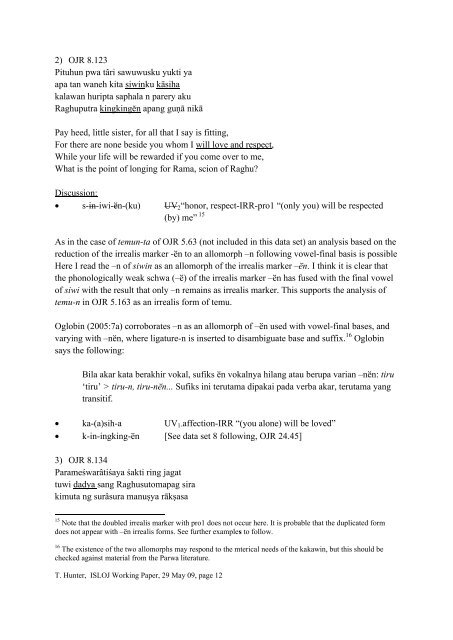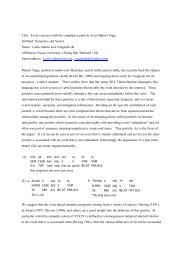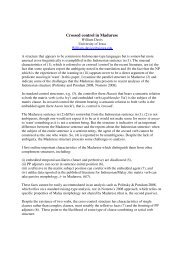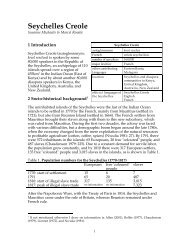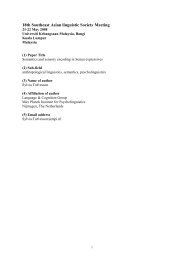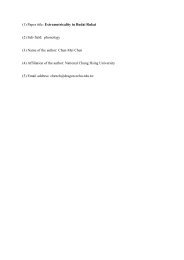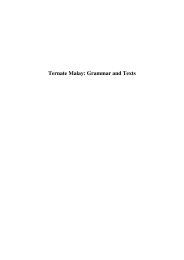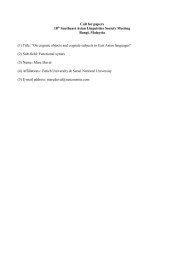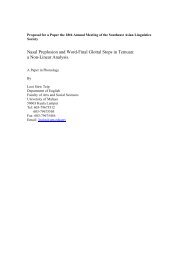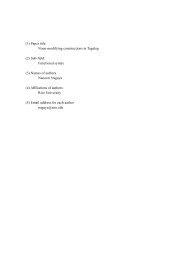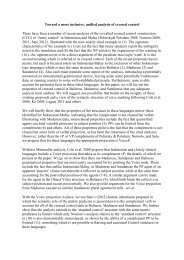Working Paper on Irrealis, Imperative Mode and Complementation ...
Working Paper on Irrealis, Imperative Mode and Complementation ...
Working Paper on Irrealis, Imperative Mode and Complementation ...
You also want an ePaper? Increase the reach of your titles
YUMPU automatically turns print PDFs into web optimized ePapers that Google loves.
2) OJR 8.123<br />
Pituhun pwa târi sawuwusku yukti ya<br />
apa tan waneh kita siwinku kāsiha<br />
kalawan huripta saphala n parery aku<br />
Raghuputra kingkingĕn apang guṇā nikā<br />
Pay heed, little sister, for all that I say is fitting,<br />
For there are n<strong>on</strong>e beside you whom I will love <strong>and</strong> respect,<br />
While your life will be rewarded if you come over to me,<br />
What is the point of l<strong>on</strong>ging for Rama, sci<strong>on</strong> of Raghu?<br />
Discussi<strong>on</strong>:<br />
s-in-iwi-ӗn-(ku) UV2“h<strong>on</strong>or, respect-IRR-pro1 “(<strong>on</strong>ly you) will be respected<br />
(by) me” 15<br />
As in the case of temun-ta of OJR 5.63 (not included in this data set) an analysis based <strong>on</strong> the<br />
reducti<strong>on</strong> of the irrealis marker -ӗn to an allomorph –n following vowel-final basis is possible<br />
Here I read the –n of siwin as an allomorph of the irrealis marker –ӗn. I think it is clear that<br />
the ph<strong>on</strong>ologically weak schwa (–ӗ) of the irrealis marker –ӗn has fused with the final vowel<br />
of siwi with the result that <strong>on</strong>ly –n remains as irrealis marker. This supports the analysis of<br />
temu-n in OJR 5.163 as an irrealis form of temu.<br />
Oglobin (2005:7a) corroborates –n as an allomorph of –ӗn used with vowel-final bases, <strong>and</strong><br />
varying with –nӗn, where ligature-n is inserted to disambiguate base <strong>and</strong> suffix. 16 Oglobin<br />
says the following:<br />
Bila akar kata berakhir vokal, sufiks ӗn vokalnya hilang atau berupa varian –nӗn: tiru<br />
‘tiru’ > tiru-n, tiru-nӗn... Sufiks ini terutama dipakai pada verba akar, terutama yang<br />
transitif.<br />
ka-(a)sih-a UV1-affecti<strong>on</strong>-IRR “(you al<strong>on</strong>e) will be loved”<br />
k-in-ingking-ӗn [See data set 8 following, OJR 24.45]<br />
3) OJR 8.134<br />
Parameśwarâtiśaya śakti ring jagat<br />
tuwi dadya sang Raghusutomapag sira<br />
kimuta ng surâsura manuṣya rākṣasa<br />
15 Note that the doubled irrealis marker with pro1 does not occur here. It is probable that the duplicated form<br />
does not appear with –ӗn irrealis forms. See further examples to follow.<br />
16 The existence of the two allomorphs may resp<strong>on</strong>d to the mterical needs of the kakawin, but this should be<br />
checked against material from the Parwa literature.<br />
T. Hunter, ISLOJ <str<strong>on</strong>g>Working</str<strong>on</strong>g> <str<strong>on</strong>g>Paper</str<strong>on</strong>g>, 29 May 09, page 12


